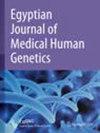Conventional and molecular cytogenetic characterization of a Moroccan patient with WAGR syndrome
IF 1.2
Q4 GENETICS & HEREDITY
引用次数: 0
Abstract
WAGR syndrome is a rare genetic disorder characterized by a de novo deletion of 11p13 and is usually clinically associated with Wilms’ tumor, aniridia, genitourinary anomalies, and mental retardation (W-A-G-R). Although the genotypic defects in WAGR syndrome have been well established. The congenital aniridia is caused, in nearly 90% of cases by mutations in the gene PAX6. In the face of congenital aniridia, it is imperative to specify whether it falls within the scope of a WAGR syndrome or if it is an isolated congenital aniridia or inherited by performing karyotype, FISH (Fluorescence In Situ Hybridization) or a CGH array for genetic counseling. We report here a case of genetic testing for newborn with aniridia, to detect 11p13 rearrangements, using karyotyping and CGH array to complete picture of the chromosomal deletions and breakpoints in aniridia. Results show either a loss of 3811.196 kb on chromosome 11 delimited by the bands p14.1 and p13 with formula or a loss of a 1867.287 kb on chromosome 18 fragment delimited by q21.33 and q22.1 bands, that has not been detected by karyotype analysis. Cytogenetics screening is a good strategy for the genetic diagnosis of aniridia and associated syndromes, allowing for a better identification of breakpoints. Our results underline the clinical importance of performing exhaustive and accurate analysis of chromosomal rearrangements for patients with aniridia, especially newborns to improve survival and quality of life for affected individuals.一名摩洛哥 WAGR 综合征患者的常规和分子细胞遗传学特征描述
WAGR 综合征是一种罕见的遗传性疾病,其特征是 11p13 的从头缺失,临床上通常伴有 Wilms 肿瘤、无肛症、泌尿生殖系统异常和智力低下(W-A-G-R)。尽管 WAGR 综合征的基因型缺陷已被明确。在近 90% 的病例中,先天性无睾症是由 PAX6 基因突变引起的。面对先天性无脑畸形,必须通过核型、FISH(荧光原位杂交)或 CGH 阵列进行遗传咨询,明确其是否属于 WAGR 综合征的范畴,或者是否为孤立的先天性无脑畸形或遗传性无脑畸形。我们在此报告一例新生儿躁狂症基因检测病例,该病例利用核型和 CGH 阵列来检测 11p13 重排,从而全面了解躁狂症的染色体缺失和断点情况。结果表明,由 p14.1 和 p13 带公式划定的 11 号染色体上有 3811.196 kb 的缺失,或由 q21.33 和 q22.1 带划定的 18 号染色体片段上有 1867.287 kb 的缺失,而核型分析未检测到这一缺失。细胞遗传学筛查是对躁狂症及相关综合征进行基因诊断的良好策略,能更好地识别断点。我们的研究结果凸显了对躁狂症患者(尤其是新生儿)进行详尽、准确的染色体重排分析以提高患者生存率和生活质量的临床重要性。
本文章由计算机程序翻译,如有差异,请以英文原文为准。
求助全文
约1分钟内获得全文
求助全文
来源期刊

Egyptian Journal of Medical Human Genetics
Medicine-Genetics (clinical)
CiteScore
2.20
自引率
7.70%
发文量
150
审稿时长
18 weeks
 求助内容:
求助内容: 应助结果提醒方式:
应助结果提醒方式:


